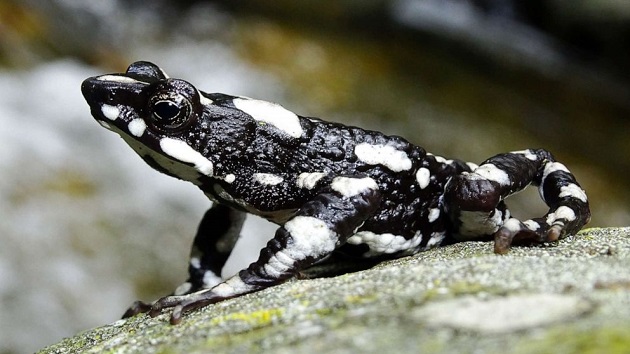Global Wildlife Conservation(NEW YORK) — Biologists have rediscovered the “starry night” harlequin toad in Colombia for the first time in nearly three decades after the species was largely wiped out by a deadly fungal pathogen.The toad, characterized by its black and white spots, was photographed in Colombia’s Sierra Nevada de Santa Marta, the tallest coastal mountain on Earth, the Global Wildlife Conservation announced on Thursday. The harlequin toad species is classified as critically endangered on the International Union for Conservation of Nature Red List of Threatened Species and typically resides in mountainous regions of Latin America.While the “starry night” subspecies was lost to scientists since 1991, it was never lost to the indigenous Arhuaco people of the Sogrome community in the Sierra Nevada de Santa Marta, who call it “gouna,” according to the conservation. The community has historically protected the amphibian which they consider guardians of water and symbols of fertility, and its habitat, Suarez Chaparro, a member of the Sogrome community and a biology student at the Francisco José de Cladas District University, said in a statement.As an inspiration to the Sogrome’s ancestral culture, the toad also represents a “legitimate authority of the natural world” and serves as an indicator on when to plant crops or perform spiritual ceremonies, according to the organization.”We manage our resources and conserve our home as the law of origin dictates, which means that we live in balance with Mother Earth and all of the life here,” Chaparro said. “Now we have a great opportunity to bring together two worldviews for the protection and preservation of the Sierra species: the Western scientific knowledge and the indigenous scientific, cultural and spiritual knowledge.”The documentation was made possible by a partnership between the Global Wildlife Conservation, Colombian NGO Fundación Atelopus and the Arhuaco people. The toad was largely not documented because biologists could not gain access to its habitat, which includes an eight-hour hike and required permission from the indigenous community.The Fundación Atelopus was allowed to see the toad in April after four years of negotiations with Sogrome spiritual leaders but were not yet permitted to take photos. The community later granted scientists to take photos after they determined that they “genuinely” shared the community’s interest in protecting the Sierra Nevada range.Biologists went in expecting to find one individual toad but instead came across a population of about 30, said Fundación Atelopus Vice President and biologist José Luis Pérez-González.”We were full of joy and hope as we had the chance to observe a healthy population from a genus for which very few species remain,” Pérez-González said.The partnership among the groups is a “powerful” example about how working with indigenous and local communities can help scientists rediscover and better understand how species survive, Lina Valencia, Colombia conservation officer at Global Wildlife Conservation, said in a statement.”We are tremendously grateful to the Arhuaco people for giving us this opportunity to work with them,” Valencia said.The starry night harlequin toad is one of four harlequin species with “seemingly steady populations” living in mid-to-high level elevations in the Sierra Nevada de Santa Marta, which has surprised biologists due to the association of dramatic amphibian declines with high elevations, according to the conservation.The Sierra Nevada de Santa Marta is “one of the most important sites for the conservation of harlequin toads in Latin America,” Luis Alberto Rueda, professor at Universidad del Magdalena and Fundación Atelopus co-founder, said in a statement.Eighty of the known 96 harlequin toad species are critically endangered or extinct as a result of infectious disease, habitat destruction and degradation, invasive species and climate change, according to the IUCN. As of 2018, 37 harlequin toad species had disappeared from their homes and have not been seen since the early 2000s, despite efforts to find them. Copyright © 2019, ABC Audio. All rights reserved.












